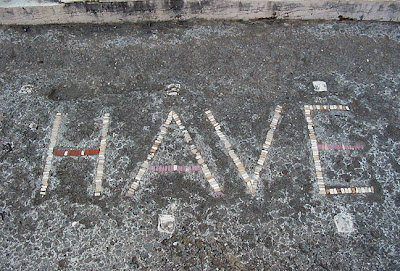 |
Trompe l'oeil debris was a popular Roman and Hellenistic mosaic theme for dining rooms floors.
Discarded fish and fruit: fragment of an asaraton, or unswept floor mosaic from Aquileia. |
detail of a 5th century floor mosaic of a Roman triclinium (dining room) which itself features
an unswept floor mosaic
 |
asaroton signed by Heraklitos, from Vigna Lupi, Rome, 2nd century, in the Vatican Museum
photo by magistrahf |
 |
| detail of Heraklitos mosaic above, Vatican Museum |
 |
| mouse and walnut— look at the shadows! |
 |
| chicken foot on the floor! |
|
|
 |
"Have" (a variant of "Ave" meaning “Hail”) is a charming mosaic greeting at the entrance to
the House of the Faun, Pompeii |
 |
Much more common, it seems, was the Cave Canem/Beware of the Dog entry hall mosaic
A popular sort of "unwelcome mat".
This well-known example is from the House of the Tragic Poet, Pompeii. |
Unswept:
Asaroton (or
asarotos oikos, "unswept room") is a great term I discovered regarding ancient Roman and Hellenistic mosaic work.
The word is Greek but it was a common Roman genre in which the floor of the triclinium, or dining room, would be decorated with food scraps seemingly cast onto the ground from the very dining tables at which guests would be seated. The realistically modelled debris included fish bones,
snails, shrimp heads, fruit rinds, nutshells, and the occasional vermin.
The fascinating room scene at top is believed to be from a 5th century dining room floor. It shows an actual dinner in progress with an asaroton floor design in the room—OR does it show a dinner with a very messy bunch of people who have actually thrown their food on the floor? Its quite a "meta" take on the style.
The first explanation of the asaroton comes from Pliny (c.77-79 AD) describing a notable work in Pergamon, probably from the 2nd century BC:
The most famous in that genre was Sosos who laid at Pergamon what is called the asarotos oikos
or unswept room, because on the pavement were represented the débris of
a meal, and those things which are normally swept away, as if they had
been left there, made of small tesserae of many colours. - Pliny,
Natural History
So from the 2nd century BC they were still doing the unswept thing in the 5th century AD. Obviously interior design trends cycled more slowly then.
Unwelcome:
Just about everyone is familiar with the
cave canem dog mosaic shown above, from Pompeii. I hadnt realized how commonplace these snarling decorative canines were. I also hadnt realized that the
dogs one was to cave are thought to be the Molossus,
an ancient breed now extinct. The dogs were eponymously named for the
Molossians, a tribal people from Northwestern Greece and what is now lower Albania. Molossian shepherds of Epirus in the mountains of northwestern Greece were renowned for vicious hounds which were used to guard their flocks and for hunting. The Molossus is considered to be the
ancestor of today's Mastiff-type
dogs and ostensibly contributed to the development of powerful modern
breeds such as the St. Bernard, Great Pyrenees, Rottweiler, Great Dane,
Newfoundland, and Bernese Mountain Dog... I have to say I'm a little dubious because these mosaic doggies seem rather too sleek and jackal-like to be "vicious guard hounds."
The Ancients had quite a sense of humor—who knows maybe these are the equivalent of pink garden flamingos. //
See next mosaic post on
memento mori at (or under) the table.












